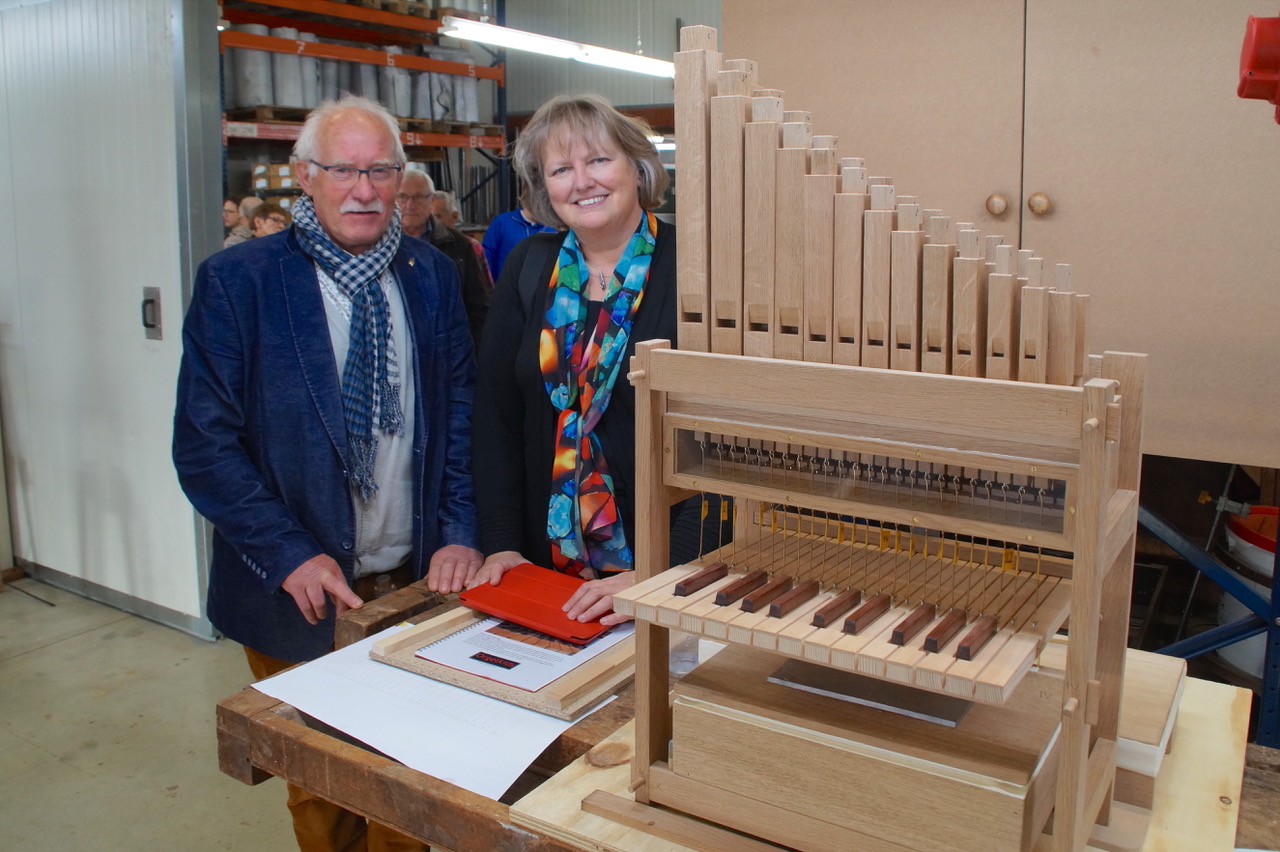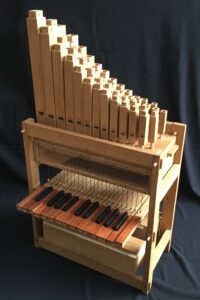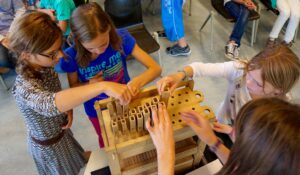
Founder of Orgel Kids, Lydia Vroegindeweij, and organ builder Wim Janssen. ©Orgelkids
Thirteen years ago the passion of Lydia Vroegindeweij for organs became a project that today reaches thousands of children worldwide. Orgelkids is an educational programme to let children discover this instrument through a so-called “Do-Organ”. With this wooden organ that can be assembled in less than an hour and which is capable of playing music, the students are able to interact in a fun and approachable way with this five hundred years old instrument. It all started with a single organ in the Netherlands, but today there are 160, from the United States to Asian countries, thrilling children with a way of learning that is tailor-made for them.
We had a chat with the creator and winner of the first Religious Heritage Innovator of the Year award, Lydia Vroegindeweij, to find out more about her inspiration to create Orgelkids and the latest activities taking place.
Let me start this interview by asking you where your love for organs comes from.
It all started as a kid when I took two years of musical training during which I learned to read musical notes, play music, etc. It was my first contact with making music. Then came the moment to decide whether I wanted to continue studying music and if so to choose an instrument. Just as a coincidence, I met the organ because a neighbour of mine was also playing it at the time. Otherwise, I think I wouldn’t have chosen this instrument because it is not that well-known. I enjoyed a lot playing the organ. I am now an amateur organist.
I find it interesting that the organ was among the options of the music school. I think that today, at least in the environment I know, the options are rather limited.
Yes, the options are no longer the same in The Netherlands either. I am already 60 years old so… In my youth it was, much better.
Do you have a favourite organist or favourite composer that has inspired you?
I absolutely fell in love with music because of Bach. Not because of his organ music specifically, but for the great music he composed throughout his life. Two years ago I obtained my PhD with a thesis on Luther’s hymns and Bach’s choral cantatas. Earlier, in 2003, I visited the Bachfest in Leipzig, which was an extraordinary event to become a real fan of Bach’s music. My love for organ music came also from my teacher who was a local organist and an excellent player. In the beginning, I was not that interested in playing in a congregation. He encouraged me to do it and then I really fell in love with the organ and became more interested in playing a bigger organ in church.

Wooden “Do-Organ” used at schools. ©Orgelkids
It has been already 13 years since Orgelkids started in the Netherlands. The project has expanded worldwide to over 20 countries. How did it all start? Where did the inspiration come from to create such a big success?
I think it is important for children to meet this instrument. My motto is: why should we spend money and human resources on organ restoration, if soon nobody can play them anymore? But even if they don’t want to be an organist or organ builder, organs are a marvellous piece of technology. They are a cultural heritage that has been preserved for centuries and has so much to tell you. And it is fun to play!
In The Netherlands we have something called the “Cultural fund”, it is the biggest fund for cultural projects. They offer the possibility to create your own fund under their umbrella so I created one in my name, as my last will, because I have no children. If there is any money left after my death I wanted it to be used for a good purpose: for letting children meet the church organ.
In 2009 I started the website Orgelkids to share ideas with others that wanted to do something for that purpose. Eventually, people asked me if there was a small organ they could take to school, something that would be easy to transport by car and easy to handle in the classroom. I started a search and I was very lucky to meet Wim Janssen, the designer of the Do-Organ. He was a retired organ builder from Verschueren organ builders and he started working on the prototype of the Do-Organ to see if it was something that children could actually use to discover the instrument. When we met, I explained my project to him and he built one for me in the wintertime. The following spring I picked up the first Do-Organ.
Once I had the Do-Organ I created an educational programme around it, with worksheets, instruction cards, videos, etc. and I put it on my website. It started with one Do-Organ, and now there are 160 in 20 countries.
Did Wim Janssen build all these Do-organs himself?
No, the designer made four good copies after the prototype. We are very happy that his former employer has then adopted the project and also uses it in training young organ builders in their company. They also made the construction plans professionally available for those who want to build their own organ for personal use. Orgelkids sells this set of drawings, which helps us funding our project. These private organs are not included in the number of 160, but besides Verschueren, there are other organ builders who build the organs with our licence for their country, e.g. in the USA, in Canada and in Sweden.
What is the children’s experience like when interacting with the Do-Organ?
It’s fun to see how concentrated they discover all sorts of things while building the organ. Because at first they think “ok, the keys are on the keyboard, so now I can play”, but no, you still have no sound. Then they connect all the wires and try again, untill they discover that wind is needed to make the pipes sound. This whole process makes them understand the way the instrument works. After 45 minutes, they’ve learned the names of the different parts, how sound is produced and they understand the complexity of the organ as an instrument.
When they visit the large organ in church afterwards they already know a lot and it is more didactic and interesting than just going to the church and looking at that huge thing that makes a loud sound. And most importantly, they never forget what they learned.
The ambition with Orgelkids is not to turn every child into an organist or an organ builder. But it is important that in the future, when this young generation takes part in a committee to decide on the restoration of an organ or the sale of a church, they remember what they know about it, that when they are involved in this kind of decisions they can think “Oh I had fun learning about this when I was a child”, and that they see the need for spending money on it. Because organs certainly are an important part of our history.

Children building the Orgelkids Organ ©Orgelkids
Orgelkids is aimed at a young audience, but have you also organised activities for adults?
You can use the Do-Organ at any age. I have had 80-year-olds and they had fun too! I focused on primary school because it is easier to promote the organ in an educational environment. And also because the classroom is an easy space to combine music, technology and cultural heritage.
In The Netherlands, there is now also another programme for teenagers. It is like an extension of the primary school educational kit. It isn´t easy to be an organist at that age, firstly because it is hard to find an educational programme specifically for teenagers and second because a common reaction of their peers is ¨Why do you want to play the organ in a cold church, where is the fun in that?¨ It is easier to keep that bond with the organ when they are able to meet each other, take a trip to see church organs, and play and have fun with their hobby together. Together we are trying to reach out to these groups of young people to get them on their way, whether they want to become organists or whether they want to keep it as a hobby.
When I started there was nothing like this, only occasional school trips organised by music teachers from different schools, but not really a vision on helping children who want to play to continue their education in organ music. I am trying to encourage organists to facilitate children to discover the organ after their first introduction. For example, why not give them a free ticket for three lessons or a lesson and then a guided visit to the church organ? Encourage them to take the next step.
A continuation of the primary school education programme sounds brilliant. precisely one of the problems we heard about at our last face-to-face meeting in Sweden is the shortage of organists. How could we bridge this gap between the existing organists and the new generations?
There are quite a few good organists who are somewhat introverted. They play excellently, but don’t derive much pleasure from a meet-and-greet with their audience. I’d like to say to organists ” Be welcoming at the keyboard and on the organ bench”. But not all organists are able to welcome the public and children on the organ bench with ease and closeness.
Another problem is that for example, in The Netherlands you don’t have a full-time job as an organist. All the organists work part-time and the rest of the time they have to fill the hours composing, teaching and all sorts of other activities.
It all starts with welcoming new audiences to the Organ culture. To listen to it but also to see it closer and to explore all the technical parts of it. Even when they are complete amateurs or know nothing about organs it is important that they are allowed to feel the instrument and what it can do. Organs aren’t easy to visit. Churches are sometimes closed and even if the church is open, the door to the organ upstairs is usually closed. So without some knowledge most of the people who walk into the church only see a huge thing with a lot of pipes against the wall. An organ concert could be made more interesting to attend for a new audience accustomed to an orchestra concert where you see people playing the violin or the trumpet.
To conclude, what are the next goals of Orgelkids? Do you plan new activities in the future?
We are proud to have reached so many countries in Europe and many other around the world. The project has reached, among many others the USA, Canada, Taiwan, China, Scandinavian countries, Spain, Germany, Austria… Many of the project managers visited me so that I could provide them with short training on the Do-Organ and we share dreams and activities. We are now helping someone in New Zealand to get the project started there.
About other projects, I am now developing a performance for all ages about Saint Martin, the old saint of the 4th-century fortress who gave half of his robe to a beggar. We will use church music as a thread running through the story and of course the Do organ is part of the performance. I am creating the story with a writer, an actor, an organist, a choir director, etc. Once this is developed, it will be available for other churches devoted to Saint Martin, to bring the activity to their schools and public.
Last year I published a book in Dutch, with all kinds of activities around the organ described for primary and secondary school. I want to make this information available on a website in different languages. It should be possible for others to bring their input and to share their knowledge and experiences on this topic (like the way a Wikipedia website works). With an editorial board composed of project managers from the different countries where Orgelkids is present, this multilingual website can help others to gain more interest in an educational approach to the organ. The end goal of course is to give this special instrument a vibrant future, with inspired organists and an enthusiastic audience.





Follow us: